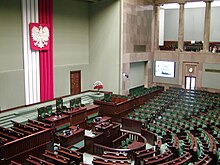Legislative procedure (Poland)
The legislative process of the Republic of Poland involves several constitutional bodies and is initiated by a legislative initiative. The procedure is based on the rules of the Polish constitution (Chapter IV, Articles 118 to 123), the rules of procedure of the Sejm and the rules of procedure of the Senate .
Right of initiative
The right to introduce a draft law or an amendment to the law in the Sejm belongs to the members of the Sejm - this must be based on a group of at least 15 members or a committee of the Sejm - the Senate , the President or the Council of Ministers . Furthermore, a draft can be submitted by a group of 100,000 eligible citizens.
Depending on who initiated the initiative, the draft is referred to as either a presidential, senate, government, parliamentary or citizens' draft.
procedure
Sejm
A law can be passed by the Sejm after three readings, with the first reading usually taking place in the responsible committee . If it is a draft law that relates to changes in the state order, civil rights and freedoms, the electoral law, the codes of law as well as taxes and finances, it must first be submitted to the Sejm and only then be forwarded to the committee. The respective committee prepares a committee report which is presented to the Sejm.
During the second reading, MPs, the Council of Ministers and the applicant have the opportunity to introduce changes to the draft law. If this happens, the amended draft must again be submitted to the committee for examination, which reports to the Sejm again. Until the end of the second reading, the applicant has the opportunity to withdraw his draft.
The third reading consists of the Sejm's vote on the draft. The draft is passed with a simple majority , with at least half of the MPs present.
If the ratification of an international treaty according to which national competences are to be transferred, a two-thirds majority is required . A referendum can also be held.
Once the law has been adopted by the Sejm, the Sejm Marshal forwards it to the Senate.
senate
The law is forwarded to the responsible Senate committee, which has to submit a report to the Senate within 18 days. Then the law is discussed and voted on by the Senate. The Senate can either reject the law as a whole with a simple majority with at least half of the senators present, accept it without changes or make changes to it. The law is deemed to have been adopted if the Senate does not comment on it within 30 days.
If the law has been rejected by the Senate, it goes back to the Sejm. This can contradict the rejection by an absolute majority ; the law is then accepted and presented to the President for signature. If the rejection is not contradicted, the law is rejected and the legislative process ended.
If the law is changed by the Senate, it also goes back to the Sejm. The Sejm can object to the changes with an absolute majority and thus accept the law in its original form or accept the changes and bring the law changed by the Senate into force.
President
The adopted law is presented to the President for signature. If he signs the law, it will enter into force within 14 days, unless another date is provided. The legislative process is thus ended. However, he can also use his veto and must then decide whether to submit the law within 21 days to the Sejm with justification for further processing or to forward it to the Constitutional Court to review its constitutionality.
If the president submits the law to the Sejm again, the latter can reject the objections with a 3/5 majority and demand that it be signed. The president is then obliged to sign it. If the president's objections are not rejected, the law is rejected. In both cases the legislative process is over.
If the President signs the law, it will be published in the Official Gazette of Dziennik Ustaw .
Constitutional Court
If the President submits the law to the Constitutional Court for review, it can declare the law in whole or in part to be constitutional or unconstitutional .
If the constitutional court recognizes the law as constitutional, the president cannot refuse to sign it. If the Constitutional Court declares the law as a whole unconstitutional, the President will refuse to sign it.
If the Constitutional Court only recognizes individual provisions of the law as unconstitutional, which are not inextricably linked with the entire law, the President can sign the law without the unconstitutional provisions or submit it to the Sejm in order to remove the objected points.
Fast legislative process
If a bill is declared urgent, the Senate has only 14 days and the President only 7 days to deal with it.
Constitutional amendments
The articles of the Polish constitution, like some articles of the German Basic Law , are not protected by an eternity clause (Article 79 Paragraph 3, Basic Law). If articles in Chapters I, II or XII are to be changed, Article 235 requires a referendum to be held within 60 days of the application, if the President, the Senate or one fifth of all MPs so request within 45 days of adoption. Constitutional changes cannot be made during a state of emergency . In the Sejm, a two-thirds majority is required to pass constitutional amendments and an absolute majority in the Senate.

